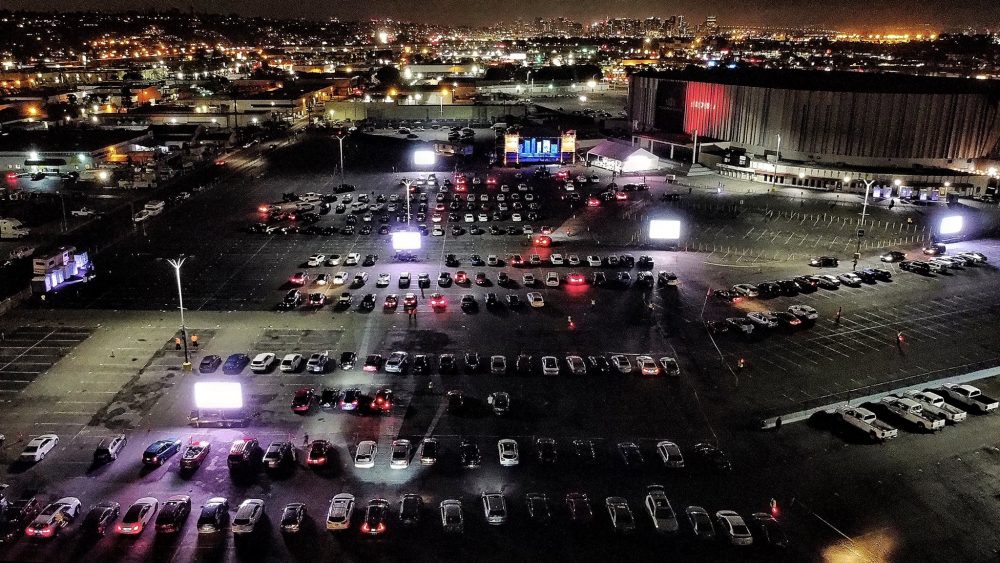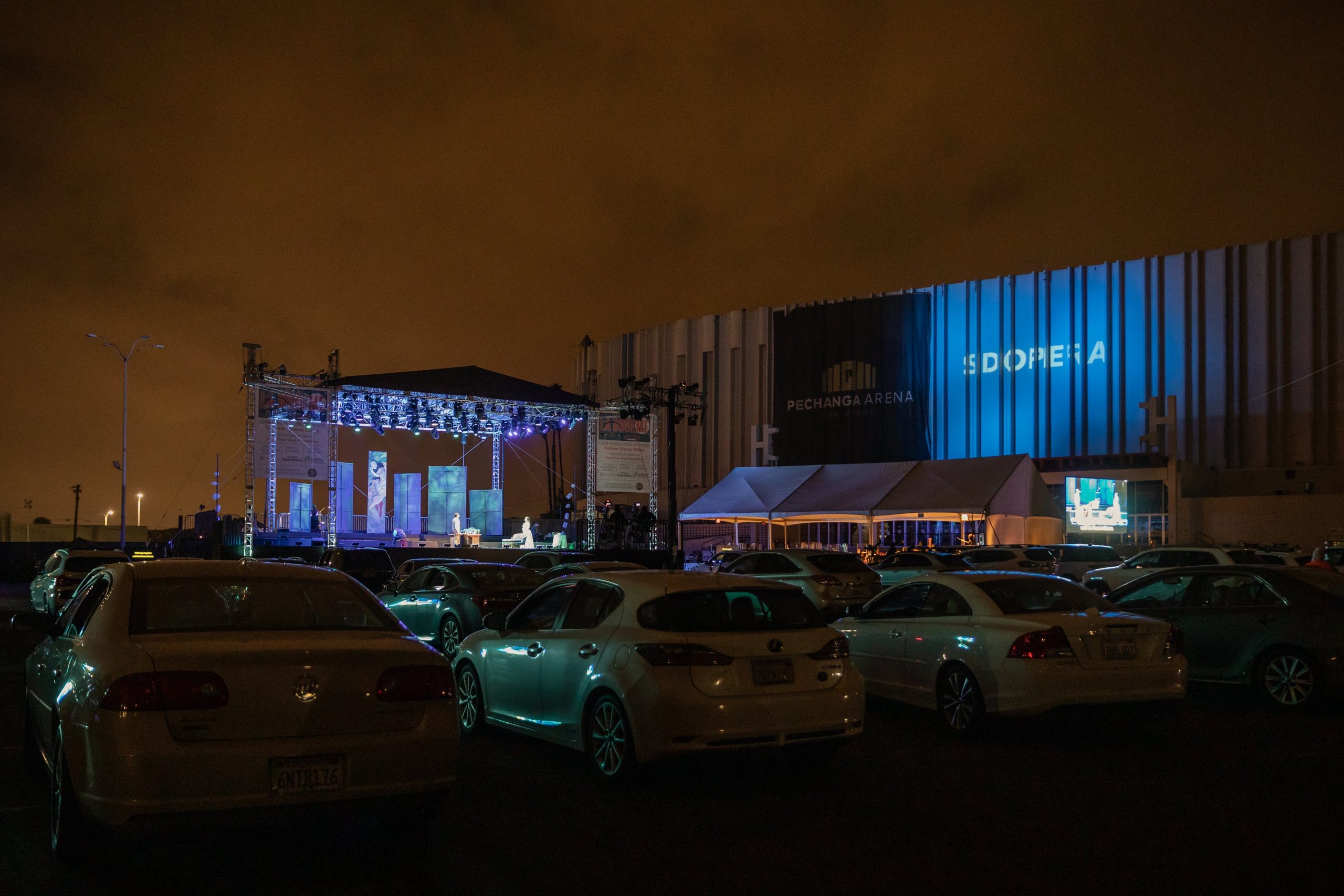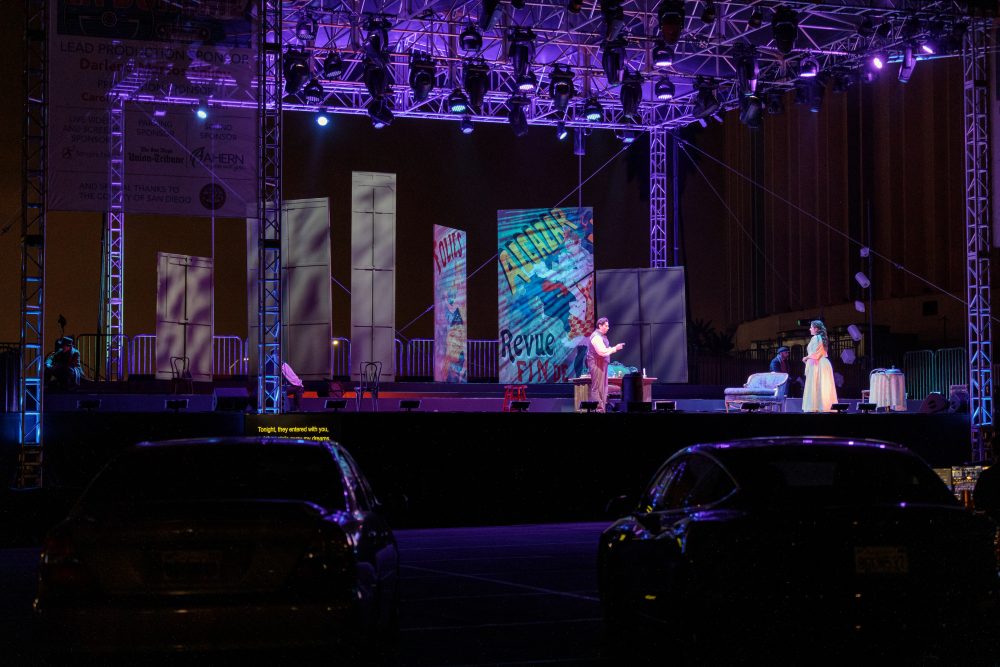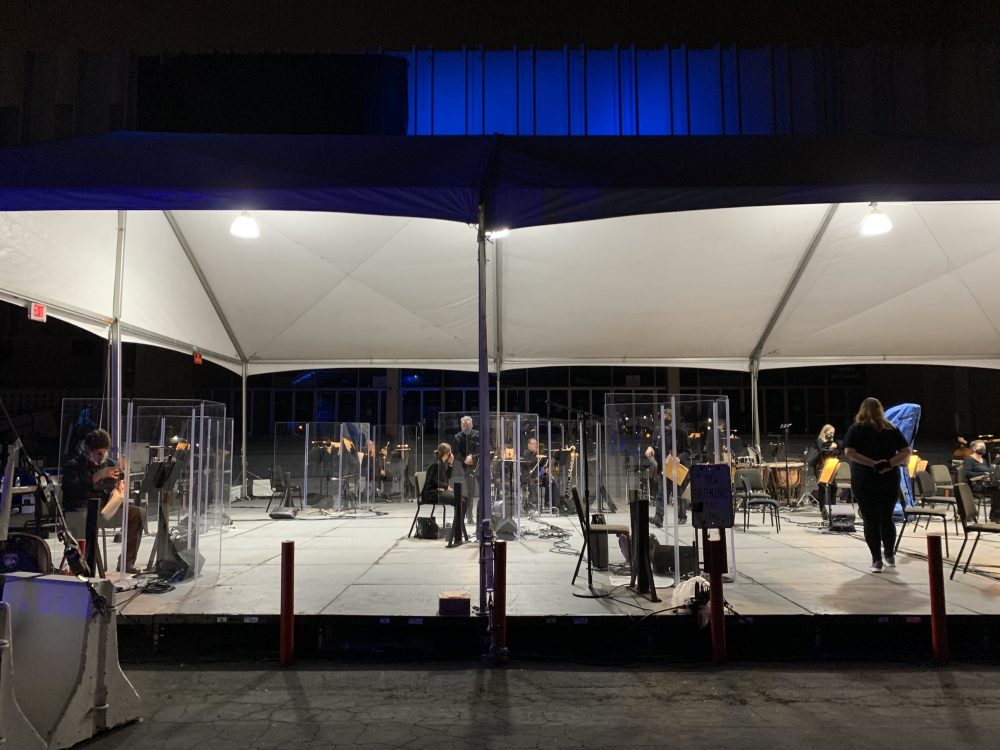San Diego Opera partnered with Event Wave Productions for its innovative new drive-in opera series, beginning with “La bohéme” at the Pechanga Arena parking lot in October 2020. Event Wave provided all audio equipment used in the production, with sound design by Event Wave principal Ross Goldman. San Diego’s first ever drive-in opera, the unique production was critically praised as a “logistical and artistic triumph” by the San Diego Union-Tribune.
“The absence of an outdoor sound system meant that anyone who left their vehicle Saturday to walk to portable restrooms alongside the arena heard almost nothing, beyond cars whizzing by on nearby Interstate 8 or a periodic siren.
The decision to forgo a sound system was an astute one. It allowed veteran sound designer Ross Goldman and his crew to expertly craft a crisp audio mix that nicely balanced the singers and the orchestra, which was sensitively led by San Diego Symphony Music Director Rafael Payare.”
George VargaSan Diego Union Tribune Review of San Diego Opera's Drive-In Production of "La Boheme"
Mix and Broadcast
San Diego Opera Director David Bennett cites Mainly Mozart’s drive-in series, another Event Wave project, as a key inspiration to produce a drive-in opera. After commenting on the level of clarity, detail, and nuance in the Mainly Mozart stereo FM broadcast mix, Bennett decided to proceed with an FM-only audience experience for the opera. The complexity and expense of a large outdoor PA system could be avoided, while still delivering a front-row audio experience, through car stereos, to every single audience member in the parking lot – even in the last row.
Because the show mix was a broadcast-only experience (as opposed to a typical PA mix), Event Wave outfitted a production trailer with a broadcast-style control room for Local 122 A1 Jason Chaney to mix the performances. With limited space available but a high channel count needed, Event Wave provided a compact yet powerful Yamaha CL1 digital mixing console to mix the broadcast as well as 14 monitor mixes. Onboard processing included the acclaimed Buss Comp 369 VCM buss compressor to deliver a warm, uniform final FM mix. Outboard processing included Waves WNS noise suppression, to mitigate the nearby freeway noise, and Waves IR-Live impulse response-based convolution reverb, to provide the highest quality, most realistic reverbs possible in an otherwise reflection-free parking lot.
Sound effects playback and routing were handled by Figure 53’s QLab, controlled via MIDI by the CL1.
Waves Tracks Live provided virtual soundcheck facilities, allowing Goldman and Music Supervisor and Arranger Bruce Stasyna to continue fine tuning the mix in between rehearsals, from balancing the sections of the orchestra, to tweaking the timbre of each instrument to achieve the most natural sound, to adjusting reverb parameters to help glue the mix together.
Genelec 1029A monitors, along with a QSC KSub, covered the audio control room, while a series of Foster 6301B monitors provided show program to the video crew and stage management.
The show was broadcast to the audience via Event Wave’s FM Transmission system, including redundant CyberMax transmitters and custom roof-mounted antenna arrays.
“The sound in the car was pretty impressive. The San Diego Symphony, performing just next to the stage in an open-sided tent, sounded full and lush … With just seven total singers in the pared-down story, the voices were clear and full.”
Julia Dixon EvansKPBS Review of San Diego Opera's Drive-In Production of "La Boheme"
 Microphones
Microphones
With discerning audience members actively listening to the broadcast mix in their cars (with no acoustic sound), microphone quality was as critical as ever. Principal singers were mic’d with industry-leading DPA 4061 miniature omnidirectional microphones, transmitted via Shure Axient Digital bodypack transmitters. The Opera’s costumes and wigs departments were instrumental in effectively hiding the microphones such that they disappeared even in close-up camera shots. Because the principals stayed onstage from their first entrance through bows, each was double-mic’d with (2) DPA 4061 and (2) Axient Digital transmitters for full redundancy. Thanks to the proven reliability of Axient Digital wireless, the backup mics were never needed, but remained available at the touch of a button should an issue have occurred.
Because of the ambient noise and wind conditions in the parking lot, the 24-piece orchestra was close-mic’d with a range of studio-quality microphones, including DPA 4061 for all strings, Neumann KM150 for all woodwinds, and a mix of Shure and AKG microphones for percussion, brass, and harp. All orchestra microphones were pre-amplified and digitized via a Rio3224-D2 I/O rack located near the orchestra stage.
Stage Monitors
With singers and orchestra on separate, side-by-side stages, monitoring was critical to the musical success of the opera. On the orchestra stage, a number of L-Acoustics compact coaxial speakers were deployed to provide reinforcement of the singers as well as general orchestra foldback, including reverb, to help provide a sense of space and reflections missing in the outdoor venue. Ultra-compact L-Acoustics 5XT speakers were distributed throughout the string section, while woodwinds, brass, and percussion were covered with individual X8 monitors.
On the main stage, a series of L-Acoustics X12 monitors provided foldback throughout the multi-tiered stage, augmented by nearly invisible Meyer MM-4XP miniature speakers hidden in scenic elements. Due to the unusual side-by-side arrangement of the main stage and orchestra stage, the acoustic arrival times of the orchestra varied greatly from one side of the stage to the order. Because certain brass and percussion instruments could be heard on the main stage, Goldman built a delay matrix in the CL1 console, allowing the orchestral content of each stage monitor to arrive in sync with the acoustical sound at that position onstage. The result was a unified, clear orchestral mix blanketing the entire stage.
Intercom
With the production crew spread over vast distances outdoors, intercom was an essential element of the sound design. Event Wave’s Clear-Com HelixNet Digital Intercom and FreeSpeak II Wireless Intercom systems were key to the successful production. A HelixNet IP network was deployed in all key areas, connecting the production trailer, main stage, orchestra stage, and FOH lighting position. A FreeSpeak II wireless transceiver network was deployed in all of the same areas, as well as in the dressing rooms located hundreds of feet away inside the arena building. This allowed stage managers to walk performers from the indoor dressing rooms to the outdoor stage while staying connected. A parking lot transceiver allowed the director and assistant director to communicate with each other while parked in different cars on opposite sides of the parking lot.
During technical rehearsals, the HelixNet and FreeSpeak II systems were carefully integrated via the CL1 with the production microphones, stage monitors and orchestra monitors, allowing the director, conductor, and production stage manager to easily communicate with the singers, orchestra, production crew, in both public announce and private channels – all easily selectable at the touch of a button. During performances, opera score readers relayed cues at specific musical moments to key audio and video crew via dedicated intercom channels, minimizing crosstalk and delivering information to those who needed it.
Nearly 20 separate intercom channels were provided to facilitate departmental private lines and sound system integration.
Safety
Comprehensive safety protocols were followed by all crew, performers, and audience members, including COVID tests, daily health screenings, social distancing, and mask wearing.
Photos Credit: Karli Cadel


